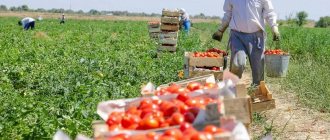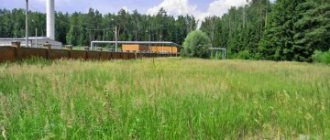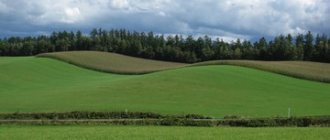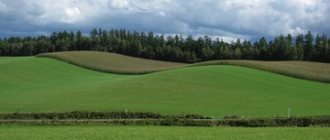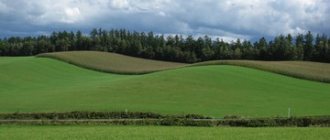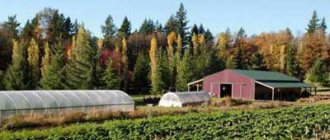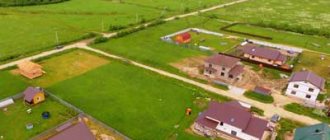Category (purpose) of SNT lands
The category is the main criterion for determining the intended purpose of land and the parameters of its use. The division of lands into categories is a consequence of the zoning of territories, for each of which its own use strategy and characteristics are established, as well as the legal regime of use. For example, agricultural lands include areas with fertile soils suitable for growing crops, forest lands must be covered with forest vegetation, and specially protected natural areas are essential for preserving the ecological environment, flora and fauna, etc.
Alexander Vasiliev
Lawyer
The intended purpose and types of permitted use of land in the SNT are determined in the documents for the land plot on the basis of more general cadastral (and sometimes town planning) documentation. During the formation and cadastral registration of a newly created land plot, it “inherits” these characteristics from the land on which it is located.
The Land Code of the Russian Federation defines 7 categories of land: lands for agricultural purposes, settlements, special use (industry, energy, transport), forest and water funds, specially protected areas and objects (SPNA), reserve reserve lands.
Owners and buyers of land most often encounter agricultural land or land in populated areas. Less common are lands transferred from the forest fund, defense lands (former sites of the Ministry of Defense), water fund and others. If there is a change in land category in the history of the site (especially recent), you need to be more careful when checking the purchase. An illegal change in the category of land may be challenged, which entails the risk of losing money invested in it.
What can't be built?
On areas allocated for gardening, you cannot build:
- industrial facilities;
- business, commercial, domestic or municipal buildings;
- healthcare, social and cultural facilities;
- shopping malls, shops;
- infrastructure construction.
In addition to the general requirements, there are also regulations for the construction of garden houses. Such rules are adopted by the partnership and local urban planning services. If local regulations are violated, the owner may be required to demolish the constructed facility.
Change of land category
The legislation provides for certain mechanisms for replacing one category of land with another. At the same time, transferring land from agricultural to another category is significantly complicated. Agricultural lands are transferred to another category in a limited number of cases (Article 7 of the Federal Law “On the transfer of lands or land plots from one category to another” No. 172-FZ of December 21, 2004).
Alexander Vasiliev
Lawyer
The most common case is a change in the boundaries of settlements, when former agricultural lands become part of the settlement. Such a transfer is practically impossible for a separate plot of land. In relation to gardening in general, its implementation is possible, but in practice it will require significant effort.
The transfer of SNT lands to the boundaries of a populated area makes it possible to entrust the local administration with the responsibility for the common gardening property. If roads and common gardening areas become part of a settlement, responsibilities for their maintenance may be transferred to the municipality.
To change the boundary, it is necessary to approve new urban planning documentation (master plan and land use and development rules), which will require a lengthy procedure for the development and approval of documents.
Law on the use of plots in SNT
The abbreviation “SNT” means a gardening non-profit partnership - a special type of association of owners of real estate (land plots) located in a certain territory. Servicing common interests (such as organizing water and energy supplies, maintaining common property, cadastral work) is organized by the governing bodies of SNT - the board and the chairman. At the same time, the supply of gardeners with electricity, water and other resources can be organized both through SNT and directly by land owners who have entered into agreements with sales companies supplying utility resources to the population. Land in SNT is privately owned. Ownership of a particular plot appears after its purchase, donation or inheritance.
Historically, SNTs were located on agricultural lands located outside populated areas. These land plots are intended for gardening and vegetable gardening for the personal needs of citizens.
Federal Law No. 217-FZ of July 29, 2021 provides the right to place garden and residential buildings, outbuildings and garages on the plots (Clause 1, Article 3 of the Law). If necessary, you can register with SNT at your place of residence, which gives additional rights when using the services of nearby infrastructure (clinics, kindergartens, schools). To do this, you need to assign an address to the house in SNT.
Difference from DNP
SNT and DNP in general are not much different, but there is still some difference between them. SNT mainly refers to agricultural lands located outside populated areas. DNP is an association of owners of summer cottages, the location of which is not subject to strict requirements. They can be located both within a populated area and outside it. In general, land in the DNP has fewer restrictions on use, and therefore, as a rule, is more expensive.
Currently, the provision of land plots from agricultural lands to citizens and their associations for gardening is regulated by the Land Code of the Russian Federation, as well as the Federal Law of July 29, 2017 No. 217-FZ “On the conduct of gardening and truck farming by citizens for their own needs and on amendments to certain legislative acts of the Russian Federation".
According to Article 4 of Law No. 217-FZ, owners of garden plots of land can create gardening non-profit partnerships, which are a type of partnership of real estate owners. The distribution of land plots between members of the partnership is carried out on the basis of a decision of the general meeting of members of the partnership in accordance with the register of members of the partnership. The conventional numbers of such plots are indicated in the register of members of the partnership and the territory surveying project. In accordance with the Land Code of the Russian Federation, land plots that are in state or municipal ownership can be provided for free use to horticultural or vegetable gardening non-profit partnerships for a period of no more than five years. The procedure for providing land plots without holding a tender is determined by Article 39.14 of the Land Code of the Russian Federation. Based on clause 4 of Article 39.10 of the Land Code of the Russian Federation, an essential condition of the agreement for the gratuitous use of a land plot concluded with a horticultural non-profit partnership is the condition on the obligation of the partnership to ensure the preparation of documentation on the planning of the territory and the land surveying project, as well as carrying out cadastral work necessary for the formation of land plots plots in accordance with the approved land surveying project. According to clause 7, clause 2, article 39.6 of the Land Code of the Russian Federation, a lease agreement for a garden plot of land, which is in state or municipal ownership, formed from a plot of land provided to a horticultural or truck farming non-profit partnership, with the exception of general purpose land plots, to members of such a partnership is concluded without bidding The Land Code of the Russian Federation provides for the conclusion of a lease agreement for a land plot located in state or municipal ownership, without holding a tender, in relation to a land plot limited in circulation, which is a general purpose land plot located within the boundaries of the territory where citizens conduct gardening for their own needs, to citizens who are the right holders garden land plots within the boundaries of such a territory with a plurality of persons on the tenant side (if the need to provide the specified land plot to such citizens is provided for by a decision of the general meeting of members of a gardening non-profit partnership that manages public property within the boundaries of such a territory). According to clause 2.7 of Article 3 of the Introductory Law, until 03/01/2022. members of non-profit organizations created before 01/01/2019. for gardening, and members of horticultural non-profit partnerships created through the reorganization of such non-profit organizations have the right, regardless of the date of entry into membership of these non-profit organizations, to purchase a land plot intended for gardening, without bidding for ownership, free of charge, if such land plot complies with collectively, the following conditions: - the land plot is formed from a land plot provided before the entry into force of this Law for gardening of a non-profit organization, or another organization under which such a non-profit organization was created or organized; - by decision of the general meeting of members of a non-profit organization on the distribution of land plots between members of a non-profit organization or on the basis of another document establishing the distribution of land plots in a non-profit organization, the land plot is distributed to this member of the non-profit organization; - the land plot is not withdrawn from circulation, limited in circulation, and no decision has been made regarding the land plot to be reserved for state or municipal needs. By virtue of Part 1 of Article 6 of Law No. 217-FZ, citizens have the right to garden individually (without creating a partnership). In accordance with Part 1 of Article 5 of Law No. 217-FZ, gardening on garden land plots located within the boundaries of the gardening territory, without participation in the partnership, can be carried out by the owners or in cases established by Part 11 of Article 12 of Law No. 217-FZ , copyright holders of garden land plots who are not members of the partnership.
Type of permitted use
The type of permitted use is determined in accordance with the category of land and the list of permissible types of permitted use. Wherein:
- the list of types of permitted use available for selection is established by zoning of territories;
- The choice of a specific species from the list of acceptable ones is made by the owner of the site independently.
No additional procedures or requirements are required for selecting the type of permitted use from the established list (Clause 2 of Article 7 of the Land Code of the Russian Federation). In this case, it is necessary to declare the selected type by submitting a corresponding application to the cadastral registration authority (Rosreestr).
If we are talking about public lands in horticulture, then the choice of the type of permitted use is carried out by SNT in the event that the lands are registered as the common property of horticulture. If the earth is
If it is necessary to establish in relation to a land plot another type of permitted use that is not provided for this land plot, then the procedure becomes more complicated. In relation to such a land plot, it may be necessary to change the category and/or urban planning regulations.
What can be built on the land for gardening and vegetable gardening?
On a site intended for gardening , you can build:
- greenhouses;
- barn;
- garage;
- outbuildings for storing equipment and crops.
The construction of a garden house is also allowed, but it cannot serve as a place of permanent residence. Making it residential with the subsequent installation of communication lines is possible only if the structure is not located on agricultural land.
On plots for gardening, the list of permissible buildings is somewhat wider:
- sheds and outbuildings for storing equipment;
- premises for the harvested crop;
- greenhouses;
- bathhouse, toilet;
- other auxiliary structures.
The construction of a residential building on land for gardening is prohibited. This provision does not depend on the category of the site. To construct capital buildings, it is necessary to change the purpose of the allocated land.
Limit dimensions
Depending on the category of land, maximum minimum and maximum sizes of land plots may be established for land plots. Article 11.9 of the Land Code establishes that the minimum and maximum dimensions of a plot are established by local urban planning rules in the event that such urban planning rules apply to the relevant lands (that is, the land plot is located within the boundaries of a populated area). In addition to the maximum dimensions, the town planning regulations also stipulate other parameters of the site:
- Percentage of territory development;
- Dimensions (height) of buildings;
- The size of the indentations of buildings from the boundaries of the land plot;
- Building density and other urban planning parameters (Article 38 of the Urban Planning Code of the Russian Federation).
Urban planning regulations (land use and development rules) are established by the administration of a constituent entity of the Russian Federation or the local administration of the corresponding municipal entity.
For agricultural land plots, the maximum sizes are established in accordance with Federal Law No. 101-FZ of July 24, 2002 “On the turnover of agricultural land.” The specific sizes of plots can be determined by the law of the subject of the Federation (region, territory, republic).
Taking into account the requirements established by regulatory documents (SNiP, fire safety requirements), the minimum area of land in SNT suitable for construction is 3 acres. Such a territory allows you to build a house while maintaining the required distances from the nearest plots. Typically, the size of plots in SNT ranges from 4 to 5 acres.
The article provides general information about the content of the legislation. To get an answer to a specific question, please contact an attorney.
Construction rules
In accordance with construction standards, the construction of buildings on a garden plot must be carried out according to the following rules :
- from the house to the boundary line with the neighbor there must be at least three meters, the calculation is carried out from the nearest wall or part of the house protruding by 50 cm or more;
- buildings for animals must be located four meters from the border;
- other outbuildings - no less than a meter from the neighbor’s property.
The location of the outdoor toilet is highlighted separately :
- from the house or cellar - at least 12 meters;
- from a bathhouse, shower or well - from 8 meters.
These standards apply to both buildings within the same site and neighboring buildings. Failure to comply with regulations may result in a requirement to demolish the structure.
At the same time, pay attention to local regulations. Gardening partnerships may have their own building rules. In some cases, they allow a slight reduction in the established parameters.
It is emphasized that the total number of buildings and garden paths should not occupy an area of more than 25% of the entire territory of the site. Accordingly, gardening should be carried out on the remaining land.
